Key takeaways:
- Anti-war activism is a multifaceted movement focusing on both the prevention of conflict and the societal issues leading to war.
- Artistic expression, including visual and performance art, is a powerful tool for conveying anti-war messages and fostering empathy.
- Collaboration among activists enhances creativity and strengthens community engagement in advocating for peace.
- Sharing art through social media and community projects amplifies voices and ignites important conversations about war and its consequences.
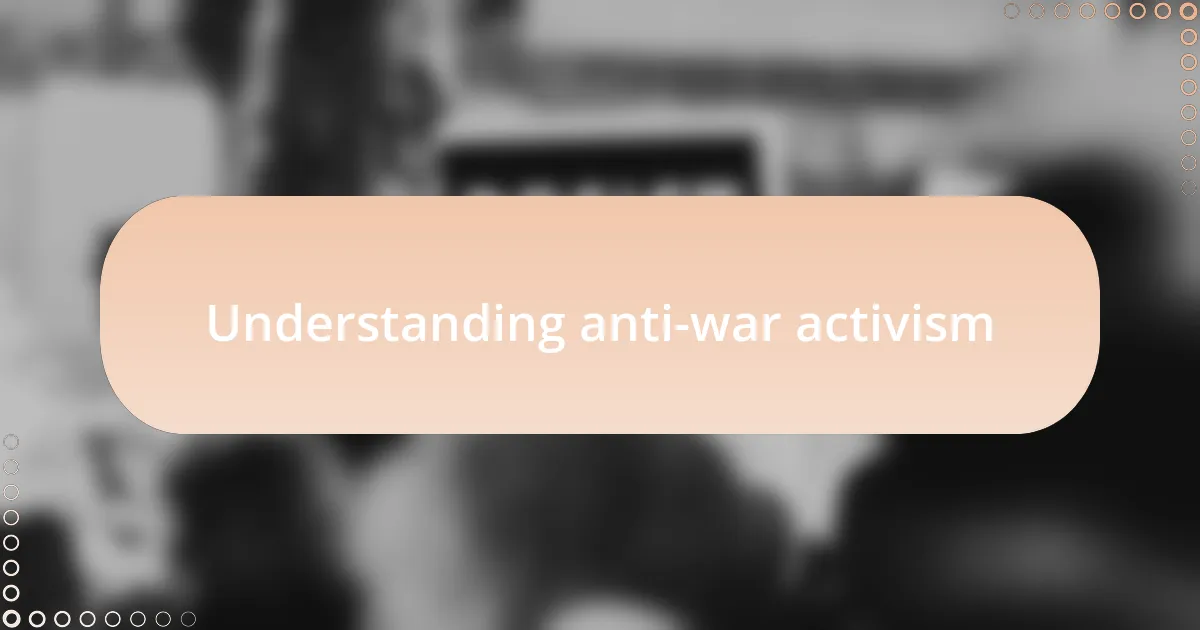
Understanding anti-war activism
Anti-war activism is a multifaceted movement that encompasses a wide range of voices united by a common goal: the prevention of conflict and the promotion of peace. I recall attending a protest where veterans shared their harrowing experiences, urging us to listen to their stories. Their pain was palpable, and it made me wonder, how many lives must be altered before we truly address the roots of war?
It’s not just about opposing military actions; it’s also about addressing the broader societal issues that lead to conflict. Sometimes I think about how economic disparities fuel injustice and unrest. Isn’t it crucial that we tackle these underlying causes just as fervently as we denounce violence? Each time I engage in conversations about war, I’m reminded that we need to cultivate empathy and understanding in our communities.
Moreover, anti-war activism often sparks conversations that challenge our perceptions. I remember discussing with friends the concept of “just war” and how complex it can be. How do we decide when war is justified, and can we ever fully grasp the implications of our decisions? These discussions reveal how deeply intertwined morality and politics are, pushing us to reflect on our roles in shaping a peaceful future.
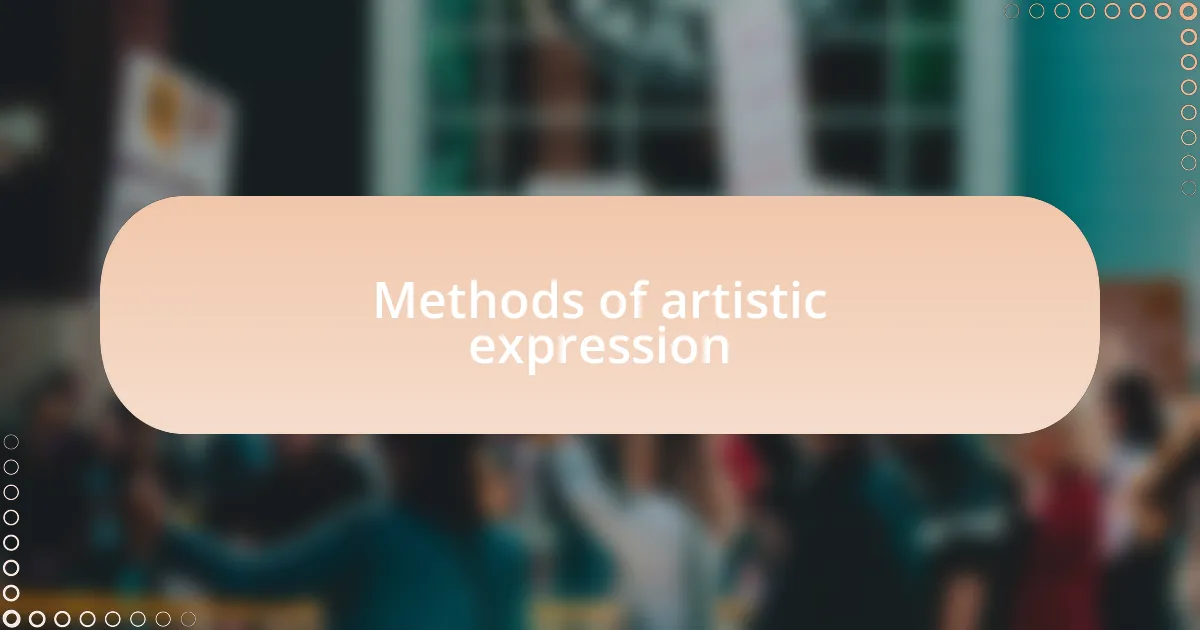
Methods of artistic expression
Artistic expression serves as a powerful tool in anti-war activism, allowing individuals to channel their emotions and messages creatively. When I attended an art exhibit focused on war and peace, I was struck by a series of sculptures made from discarded military materials. Each piece told a story of destruction transformed into hope, prompting me to reflect: How can such raw materials evoke such profound messages about our humanity?
Another method that resonates with me is the use of performance art. I remember participating in a street theater performance that depicted the experiences of refugees fleeing conflict zones. As we enacted their stories, I watched audiences react—tears in some eyes, anger in others. This visceral connection illustrates how art can bridge the gap between statistics and the human experience, igniting passion and empathy in ways that words sometimes cannot.
Lastly, digital art has emerged as an essential medium for conveying anti-war messages to a broad audience. I recall sharing a poignant animated short on social media that captured the plight of war-affected children. The overwhelming response showed me that art transcends traditional boundaries; it can travel instantly across the globe, inviting viewers into a dialogue that challenges complacency. Isn’t it inspiring to think about how our creativity can spark change and foster understanding in a fractured world?
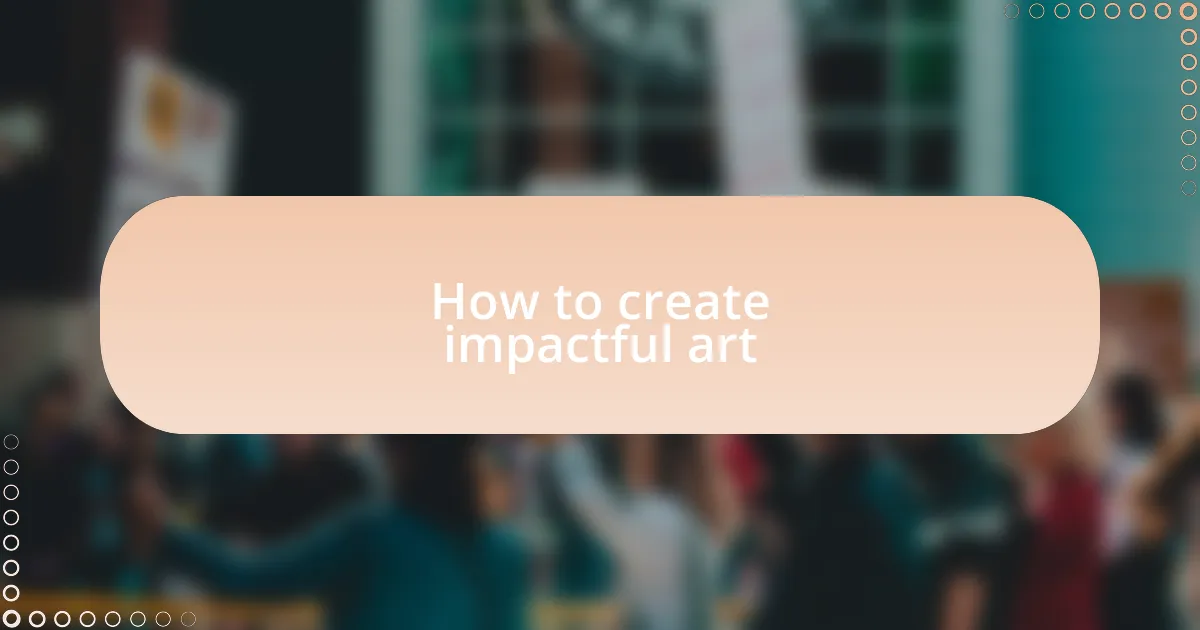
How to create impactful art
Creating impactful art begins with a genuine connection to the subject matter. I remember sketching for hours during a local peace vigil, trying to capture the raw emotions of those around me. Each stroke of my pencil wasn’t just about the image; it was about embodying their hopes and fears. How can we truly understand a cause if we don’t feel it deeply ourselves?
In my experience, using symbolism can elevate your message. One time, I crafted a mural that featured a dove surrounded by barbed wire, representing the struggle for peace amidst conflict. When community members stood before it, they interpreted the artwork in their own unique ways, fostering discussions that I never anticipated. Isn’t it fascinating how a single image can invite multiple interpretations, sparking a richer dialogue?
Finally, collaboration plays a crucial role in impactful art. I once joined forces with local poets and musicians to create a multimedia installation that reflected on the impacts of war. The collective energy transformed our individual ideas into something much greater. Have you ever noticed how when diverse voices come together, the message becomes louder and clearer? That’s the kind of synergy that can lead to real change.
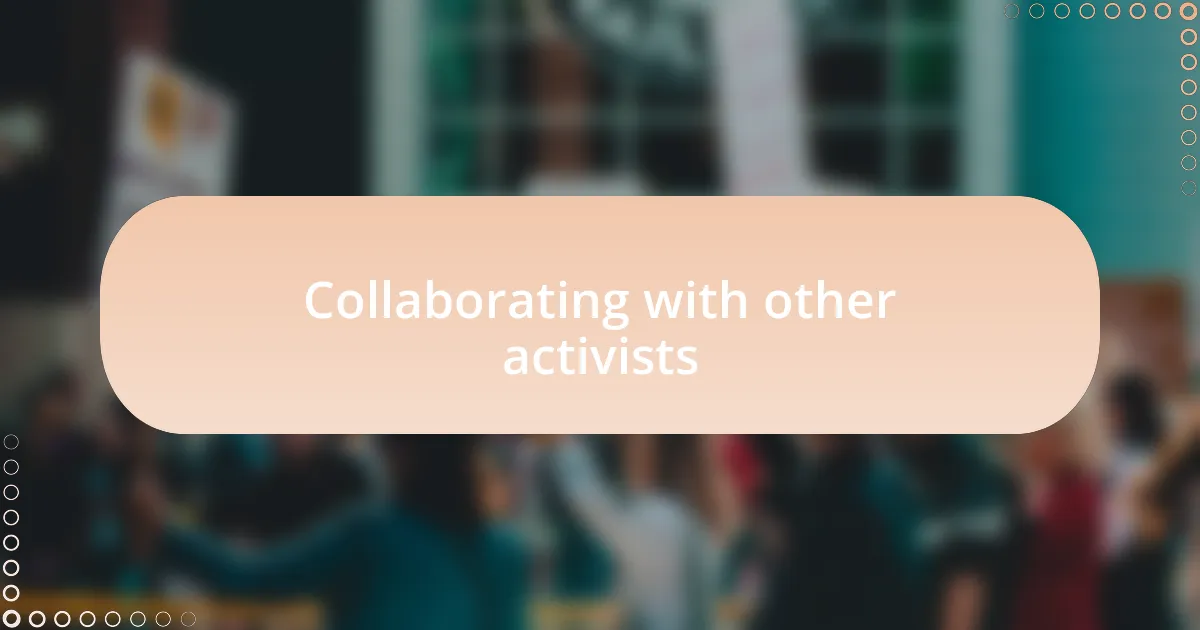
Collaborating with other activists
There’s something incredibly powerful about collaborating with fellow activists. I remember a particular project where I teamed up with a group of photographers, each capturing life in a conflict zone. Our distinct styles complemented each other; it was as if we were piecing together a mosaic of human experiences. Have you ever experienced that moment when different perspectives merge to create something truly profound?
Working alongside other activists opens up new avenues for creativity and expression. During a community arts festival, I connected with activists focusing on refugees. Together, we designed an interactive installation that allowed visitors to step into the shoes of those impacted by war. This collaboration not only broadened my understanding but also deepened the emotional resonance of our message. Isn’t it incredible how shared narratives can amplify the urgency of our cause?
Moreover, collaboration fosters a sense of unity that is vital in activism. Once, I participated in a collective art project where we painted murals in disadvantaged neighborhoods, each with a theme of hope and resilience. The process itself became a dialogue among artists and community members, reinforcing the idea that we are not alone in our fight for change. What’s more motivating than seeing a community rally together, creating a shared vision for peace?
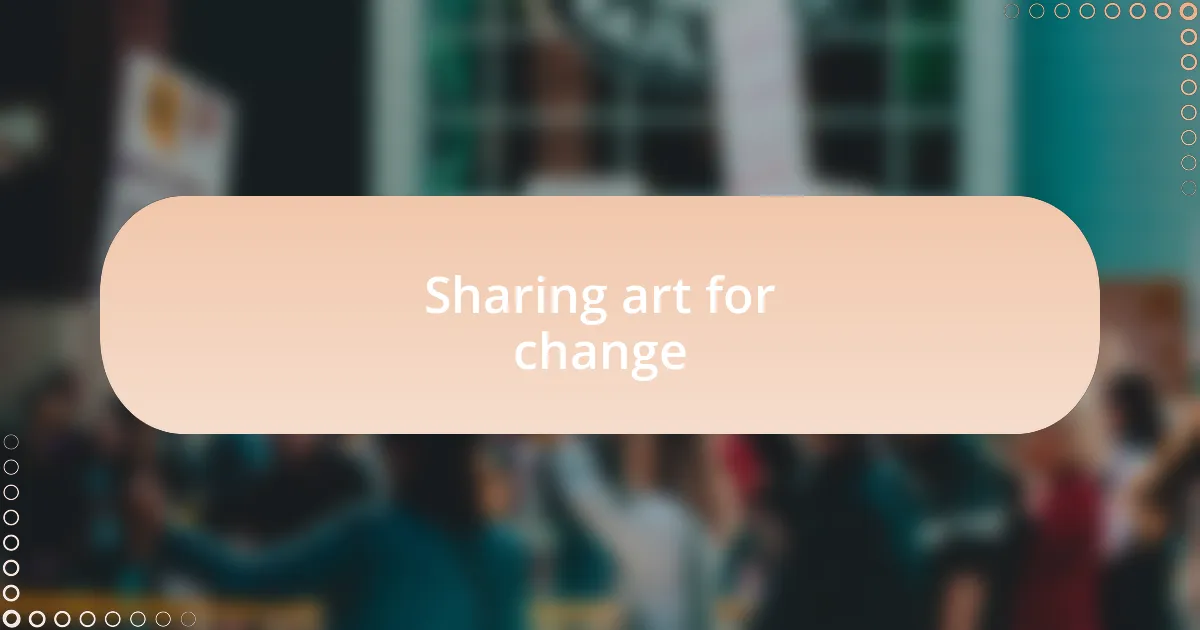
Sharing art for change
Sharing art for change takes many forms, and I’ve found that leveraging social media can amplify our collective voices. I once organized a virtual art exhibition where artists from around the world showcased their pieces related to anti-war themes. Each piece stirred raw emotions and ignited conversations that transcended borders. Doesn’t it feel empowering to see your work spark dialogue amongst people who may never meet face-to-face?
I also recall a time when I printed stickers with powerful anti-war messages and distributed them in my community. Each sticker was a small act of rebellion, a visual reminder that art can challenge the status quo. When people started sharing photos of the stickers in unexpected places, it was as if we created an underground movement. How thrilling is it to witness your message resonate beyond its initial context?
Engagement doesn’t stop at just sharing; it often evolves into something deeper. I once started a community art project called “Voices of the Silent,” where participants created artworks representing individuals affected by war, often those whose stories go untold. Watching the emotional release as participants expressed their feelings through art was profoundly moving. Isn’t it fascinating how art can provide a voice to the voiceless and unite us in our shared humanity?
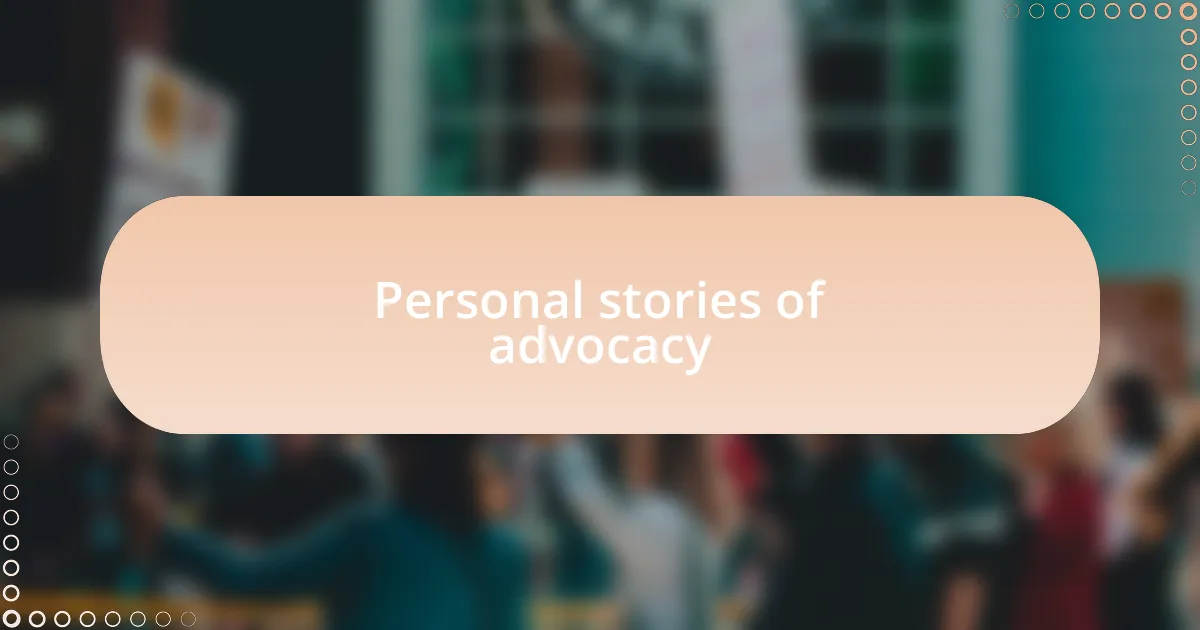
Personal stories of advocacy
Art has always been my refuge, and I discovered this power firsthand during a local anti-war demonstration. I decided to paint a large mural on a nearby wall that depicted the faces of children affected by war—innocent lives caught in conflict. As I stood there, brush in hand, I felt an electrifying connection with passersby, their emotions reflected in the eyes of my artwork. Have you ever experienced a moment where your creativity opened a door to understanding?
Another profound experience emerged from a poetry night I hosted in my neighborhood café. I invited people to share their poems related to peace and the impact of war, and one participant, a veteran, moved us all with his heartfelt piece about loss and reconciliation. It struck me how art could serve as a bridge, allowing different perspectives to converge in a space of healing. Don’t you think art paves the way for conversations many are hesitant to have?
I also remember collaborating with a group of young students on creating an interactive installation that illustrated the impact of war on our environment. As we collected items—abandoned shoes, torn flags—it became a cathartic journey for everyone involved. Witnessing the students immerse themselves in this creative process was inspiring; it reminded me that advocacy through art not only educates but also empowers the next generation. Have you ever felt the weight of responsibility that comes with using your voice for change?